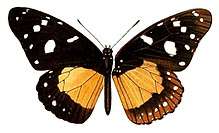Amauris echeria
Amauris echeria, the chief, is a butterfly of the family Nymphalidae. It is found in southern Africa.
| Chief | |
|---|---|
.jpg) | |
_underside.jpg) | |
| Both in Kakamega Forest, Kenya | |
| Scientific classification | |
| Kingdom: | Animalia |
| Phylum: | Arthropoda |
| Class: | Insecta |
| Order: | Lepidoptera |
| Family: | Nymphalidae |
| Genus: | Amauris |
| Species: | A. echeria |
| Binomial name | |
| Amauris echeria (Stoll, [1790]) | |
| Synonyms | |
| |
The wingspan is 55–65 mm for males and 63–70 for females. Adults are on wing year round (with peaks in summer and autumn).[1]
The larvae feed on Tylophora anomala, Tylophora stolzii, Cynanchum chirindense, Gymnema (including Gymnema sylvestre), Marsdenia (including Marsdenia angolensis and Marsdenia racemosa) and Secamone (including Secamone africana and Secamone parviflora).[2]
Subspecies

A. e. katangae Neave, 1910
- A. e. echeria – Cape to Natal, Zululand, Transvaal
- A. e. abessinica Schmidt, 1921 – Eritrea, northern Ethiopia
- A. e. chyuluensis van Someren, 1939 – south-eastern Kenya (Chyulu, Sagala, Emali, Teita)
- A. e. contracta Talbot, 1940 – western Kenya, Kitale
- A. e. fernandina Schultze, 1914 – Fernando Póo (Macías Nguema Island)
- A. e. jacksoni Sharpe, 1892 – Kenya west of the Rift Valley
- A. e. katangae Neave, 1910 – southern Zaire (southern Shaba), Zambia
- A. e. kikuyu Talbot, 1940 – eastern Kenya (Katamayu to Meru, Nyambeni)
- A. e. lobengula (Sharpe, 1890) – Rhodesia, southern Mozambique, southern Malawi (Mount Mlanje)
- A. e. meruensis Talbot, 1940 – northern Tanzania (Arusha, Moshi, Nogorongoro)
- A. e. mongallensis Carpenter, 1928 – southern Sudan, northern Uganda
- A. e. mpala Talbot, 1940 – highlands of Zaire
- A. e. occidentalis Schmidt, 1921 – Cameroon
- A. e. septentrionis Poulton, 1924 – northern Kenya (Marsabit, Nyiro, Kulal)
- A. e. serica Talbot, 1940 – southern Tanzania, northern Malawi
- A. e. steckeri Kheil, 1890 – southern Ethiopia, western Ethiopia, southern Sudan
- A. e. terrena Talbot, 1940 – western Uganda, eastern Zaire, north-western Tanzania, Rwanda, Burundi
- A. e. whytei Butler, 1894 – southern Malawi (Zomba Plateau)
gollark: By not collecting nebluae?
gollark: Cool code.
gollark: Blue nebula!
gollark: You can shorten it to ne-blu-a.
gollark: * neblua
References
- Woodhall, Steve (2005). Field Guide to Butterflies of South Africa. Cape Town, South Africa: Struik. ISBN 978-1-86872-724-7.
- "Amauris Hübner, 1816" at Markku Savela's Lepidoptera and Some Other Life Forms
- Seitz, A. Die Gross-Schmetterlinge der Erde 13: Die Afrikanischen Tagfalter. Plate XIII 24 nominate and jacksoni Sharpe, 1892
- Seitz, A. Die Gross-Schmetterlinge der Erde 13: Die Afrikanischen Tagfalter. Plate XIII 25 ssp. lobengula misspelling
| Wikispecies has information related to Amauris echeria |
| Wikimedia Commons has media related to Amauris echeria. |
This article is issued from Wikipedia. The text is licensed under Creative Commons - Attribution - Sharealike. Additional terms may apply for the media files.